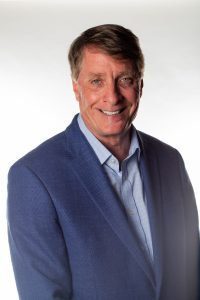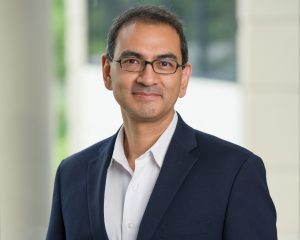
5 Questions with Brian Darmody, CEO, Association of University Research Parks
“5 Questions With…” is a weekly BioBuzz series where we reach out to interesting people in the BioHealth Capital Region to share a little about themselves, their work, and maybe something completely unrelated. This edition features 5 Questions with Brian Darmody, CEO, Association of University Research Parks (AURP).
Brian Darmody is CEO of AURP, a global nonprofit representing research parks and innovation districts sponsored by universities, federal labs, communities, hospitals, and other institutions in the US and 12 other countries.
Previously Darmody served in a variety of roles at the University of Maryland College Park, including in the President’s Office of Legal Affairs, Office of Government Relations, Office of Research and Development, Office of University Relations, and Center for Applied Policy Studies.
Before his work at UMD, Darmody worked at the US Health Care Financing Commission, the US House of Representatives, and the Maryland House of Delegates.
1. You have been here in what is now called the BioHealth Capital Region for a while. Please walk us through your career.
I was born in Montgomery County and started my career at then-Md 5th District Congressman Spellman’s Office (the B-W Parkway is dedicated to her) after an internship with her when I was at UMD College Park. Later I worked for a delegate in Annapolis and then went on to law school at night while working in the US Office of Attorney-Advisor at the Health Care Financing Administration.
I then joined UMD’s legal office, but because I had experience on the Hill and in Annapolis, I evolved to become head of government affairs for UMD. I was lucky to have some excellent presidents at UMD as my bosses, who gave me a considerable bit of autonomy to pursue projects.
They range from coming up with the idea and drafting the legislation for MD Technology Development Corporation (TEDCO), to making the terrapin the official state reptile and legally designated mascot of UMD, to developing a capital funding strategy for university tech incubators by putting the funding in the Maryland Department of Commerce (as it is called now) instead of university capital budgets where these facilities competed with academic facilities and up to then never were funded by the state.
Later I ran the UMD Center for Applied Policy Studies for 3 years, helped to launch Maryland Day, the largest university-based community open house day in the country, and developed other public policies such as the Regional Innovation Strategic Enterprise (RISE) Zone and the ENNOVATE program that provides state matching funds for philanthropic professorship endowments focused on economic development in the state.
I moved to the Baltimore area when I got married and was the only person on the boards of both the Maryland Tech Council Board and the Greater Baltimore Tech Council, and later also served on the boards of the Prince George’s Economic Development Corporation and Maryland Economic Development Association so got to see how different parts of the state viewed economic development, which was an interesting perspective to have.
2. After decades with the University of Maryland, you joined AURP as their CEO. Introduce AURP to our readers.
When I was at UMD, a physics organization called the American Association of Physics Teachers was in College Park, and they were having a disagreement with the state tax assessor on how to assess their property, and that was being resolved in Annapolis. I was introduced to them, and they told me the parent physics organization in New York City was looking for a new home.
Because UMD has a strong physics program, I thought I would make the right person aware at UMD to help recruit this organization to the state, but I found out we did not have anyone in that role (UMD would later recruit Julie Lenzer and Ken Ullman that would fill this role, and they are having amazing success bringing new community and research assets to Greater College Park). So, I began a recruitment process, and eventually, the world’s largest physics association bought land near UMD and a new CP/UMD Metro Station for their headquarters.
Once that happened, I became involved with helping create a research park in the area. I was introduced to the Association of University Research Parks, a global nonprofit that was formed in 1986 by the directors of research parks at Stanford Research Park, Research Triangle Park in NC, Arizona State University Research Park and Edmonton Canada Research Park authority. I served as the organization’s volunteer president in the 1990s and recruited them to have their international conference in 2018 at the Hotel at UMD.
When I retired from UMD, I took up the position of AURP CEO and opened the AURP DC area office in the UMD Discovery District in College Park in the WeWork. We now have members in 42 states and 12 countries, and we support research parks and innovation districts sponsored by universities, fed labs, communities, and hospital systems. Our main office is at U of Arizona Tech Parks under a partnership agreement with them to provide office and accounting support.
Our largest set of members happens to be in the DC-MD-VA (DMV), including UMD College Park, UMB BioPark, UM Baltimore County, Montgomery College PIC MC, Viva White Oak adjacent to the FDA headquarters, Children’s National Innovation Campus at Walter Reed, UVA Research Park, Va Tech research parks in Va, VCU in Richmond, and George Mason University.
We also have corporate members; AstraZeneca and Fraunhofer USA, an affiliate of Europe’s largest applied R&D organization, and MD Commerce just came on as major sponsors. It is not well known that the DMV houses among the largest group of firms in the world planning, designing, and building research parks and innovation districts, including Whiting-Turner, Clark Construction, COPT, Ballard Spahr, JLL, Scheer Partners, Alexandria Real Estate, Wexford Science and Tech, Ayers St. Gross, Perkins, and Will and others, many of whom are AURP members.
3. Now with almost 2 years under your belt at AURP. What are your goals for the organization over the next 5 years?
With a new Administration coming on board, AURP wants to support the growth of communities of innovation across the US and around the globe. Research parks and innovation districts are among the most environmentally sustainable communities in existence since they encourage live/work/research/play multi-use development, reducing the development’s carbon footprint.
We want to make sure our sponsors–universities, hospitals, cities, and federal labs– are connected to the community through childcare, workforce housing, technician training, small business training, and entrepreneurial support for founders from disadvantaged backgrounds.
We plan to work on Smart City initiatives, new energy hubs that likely will emerge with new federal investment, look to work with groups that plan to reform the Opportunity Zone (OZ) program since several of our members are in OZs and make it more functional to support business, such as biotech startups where the 10-year hold aligns with the long-term maturation of biotechnologies.
We have a great history of working alongside other economic development and innovation groups, such as the Fed Lab Consortium, State Science and Tech Institute, BIO, AUTM, iNBIA, APLU, and LISC that we plan to continue and deepen.
4. As somebody who has been part of the BioHealth Capital Region since before it even had that title, what are the biggest gaps here, AND how would you fill them?
Our region is home to the world’s largest biomedical facility at NIH, the world’s largest health services customer at the Center for Medicare and Medicaid Services (CMS), the world’s largest bioregulator, the FDA, the world’s largest biotech trade association, BIO, and the largest medical research foundation, Howard Hughes Medical Institute.
But to really be on the world stage, we need to take advantage of these great institutions and have more Jeff Galvins, more Astra Zeneca’s, and more Children Nationals.
Jeff Galvin is CEO of American Gene Technologies, making great progress on a cure for HIV and other diseases. But he is also a private-sector biotech executive that gives a lot of time to supporting the bio-industry in the region and is one of the most impassioned cheerleaders for this region.
Even though they are a British based firm, Astra Zeneca has a long history of being involved in the community, including opening its US Gaithersburg headquarters each year from a regional bio forum and helping fund the process that led to the region being branded the BioHealth Capital Region.
Children’s National Research and Innovation Campus at Walter Reed will be a centerpiece of pediatric research and innovation. There are only 13 Jlabs—innovation hubs sponsored by Johnson and Johnson—around the world, and Children’s National was able to recruit one to DC, putting our region on the map. Just as importantly, Children’s works regionally, such as with UMD College Park on a pediatric device consortium and Va Tech on a biomedical research facility at Walter Reed and is opening new facilities across the BioHealth Capital Region.
In terms of the many federal agencies we are fortunate to have in our region, we need to take better advantage of them. Unlike public land grant universities, federal labs have no specific legislatively enacted local economic development mission.
The Stevenson Wylder Act created tech transfer functions for fed labs. Like many states have created, the region should support creating a federally chartered tech transfer intermediary organization, such as TEDCO in Maryland or CIT in Virginia. This organization could be modeled on the Congressionally-chartered Jackson Foundation for Military Health that has grown in Maryland. See the paper I wrote for the MD Life Science Advisory Board (LSAB) here.
Giving all federal agencies authority to enter public-private partnerships through Enhanced Use Lease Authority is another policy that could help the region. One of the most under-appreciated federal labs in our region is the National Institute for Standards and Technology (NIST).
It manages for the federal government the tech transfer functions of agencies, develops cybersecurity standards, has a significant role in supporting manufacturing across the US, is involved with biotech research, is becoming the leader in quantum research, and has some of the world’s most sophisticated testing and metrology labs on its campus in Gaithersburg.
Imagine if private sector firms and academic facilities could be built adjacent to NIST labs as private sector firms have built research parks adjacent to DOE Sandia Labs in New Mexico, Falcon Hill AFB in Salt Lake, or NASA Moffet Field in California?
Quantum computing will have a significant impact on biotech research in the coming decades. Making sure our region anticipates the upcoming revolution in computing by taking advantage of the great resources at NIST and UMD on a regional basis will be essential as many other federal agencies and institutions will be getting involved in this topic. Given the cost and expertise needed, not many quantum hubs worldwide will emerge, but DMV can be one of them with proper investment and coordination.
Finally, we need to think more regionally than we have. Our economic development programs are organized for the most part at the county level, such as Fairfax County, Montgomery County, etc. A lot of effort is spent branding individual counties but ask yourself: what county is Silicon Valley in? What county is Research Triangle in? Technology does not pay attention to political boundaries.
Counties play important roles at the transactional level, but we need to have a more regional approach to build international brands. The BioHealth Capital Forum at AZ is one of the truly regional biotech events. Groups like the Greater Washington Board of Trade, the Greater Baltimore Committee, the Greater Washington Partnership, and the new Connect DMV are helping support this regional approach, and we need to make sure their initiatives are supported by the community, by institutions, and by businesses.
We lack a history of regional tech cooperation, but the Covid19 pandemic is opening a lot of people’s eyes to new ways of running institutions, and we should not let this moment pass.
5. If You Could Have One Wish, What Would You Pick and Why?
To be the Santa Vaccine Claus. This Dec 25, the Santa Vaccine Claus would descend chimneys across the world, and the entire population would be vaccinated from COVID19 with a temperature stable dose in one night and with a formulation that prevented the spread to new people.
Now, some elements of that are likely to happen not on Christmas Day but sometime in 2021 and with a few more complications than the Santa Vaccine Claus scenario… but I am optimistic that 2021 will be an excellent year for advancing COVID-19 19 vaccines.
Thanks to the scientists, manufacturers, and distributors working on this in the DMV, in the US, and around the world. It is remarkable to see such progress, and by Christmas 2021, we will see many parts of this scenario accomplished.
Thank you to Brian Darmody for participating in the ‘5 Questions with BioBuzz’ series and stay tuned for more interviews with others from across the BioHealth Capital Region and beyond.




